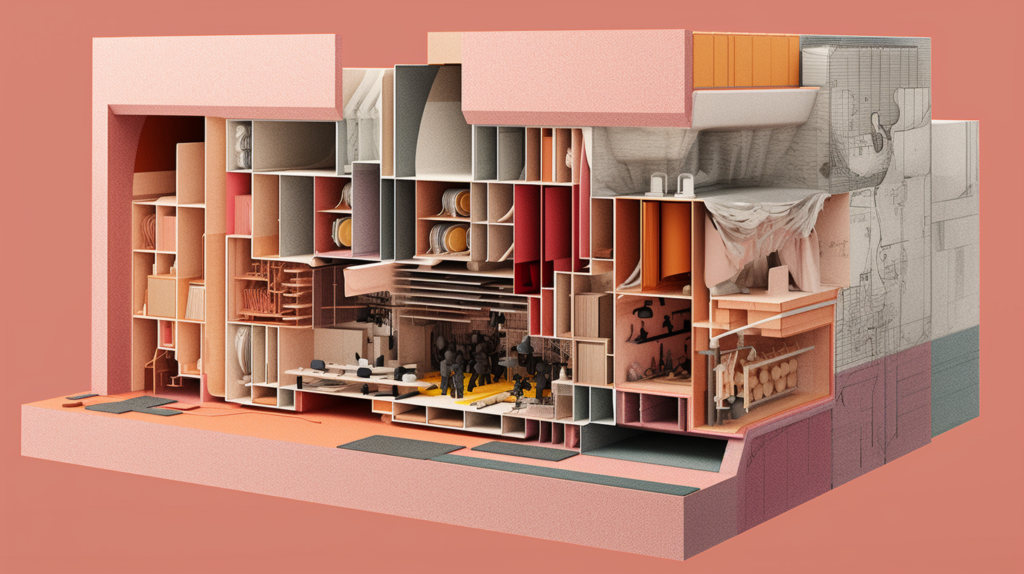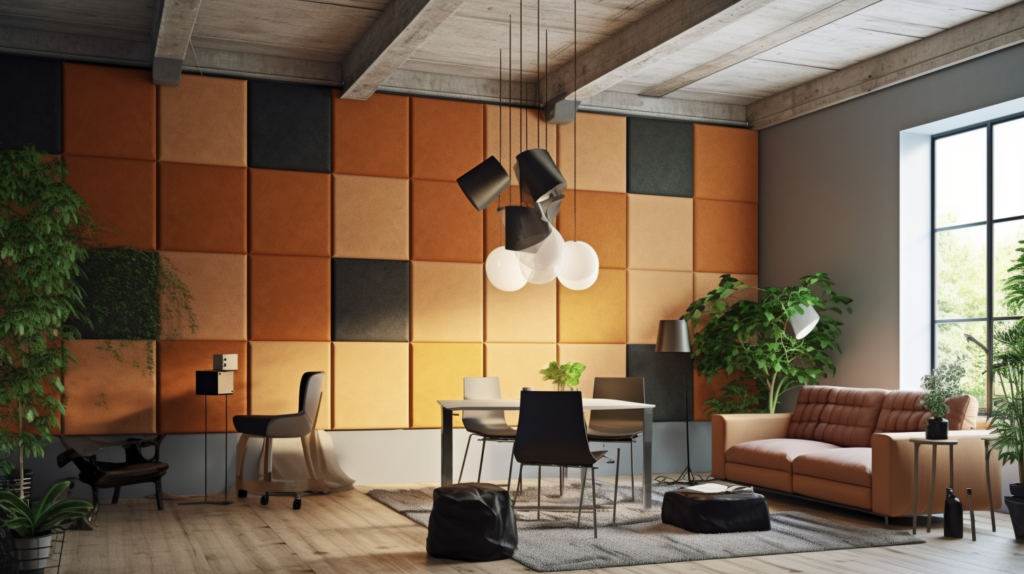Do acoustic panels actually keep sound out, despite common claims? The answer may surprise you.
Acoustic panels don’t effectively block exterior noises. They condition interior acoustics using absorption and diffusion of existing sounds.
Let’s cut through the confusion and dive into how acoustic panels work – and their limitations.
The Promise of Acoustic Panels

Many people believe acoustic panels can block outside noise from entering a room.
The idea is that the dense, sound-absorbent material will dampen noises trying to penetrate through walls, windows or doors. This seems logical, but does it actually work that way?
Can these popular interior acoustic treatments truly prevent exterior sounds from being audible inside your rooms?
Acoustic panels have become a trendy solution for audio and soundproofing needs in many residential and commercial spaces nowadays.
Homeowners, musicians, podcasters and office workers alike have embraced these panels to treat everything from bothersome reverberations to privacy concerns.
But in the quest for silent interiors, many myths and misconceptions have surfaced around what acoustic panels can and cannot achieve.
The confusion stems primarily from ambiguous terminology, since “acoustic panels” as a descriptor does not inherently differentiate between two distinct functional goals: acoustic conditioning for rooms using absorption and diffusion, versus genuine defense against outdoor noise penetration.
How Acoustic Panels Function?
To understand the sound blocking limitations of acoustic panels, you first need to comprehend precisely what purpose they are designed for., you first need to comprehend precisely what purpose they are designed for.
As the name suggests, acoustic panels are engineered to adjust and enhance a room’s interior acoustic properties rather than prevent sound from traversing exterior barriers.
They utilize porous, sound-soaking materials to tame noise issues already occurring within a space.
But preventing outside noises from infiltrating into a room is not actually part of an acoustic panel’s intended functionality.
In fact most acoustic panels freely allow the passage of sound waves through their front surfaces, welcoming external noises rather than stopping them.
Confusion over the specific operation and objectives of these common panels frequently leads to unrealistic expectations regarding soundproofing capacities.
Acoustic panels reduce unwanted interior echoes and reverberation through two key mechanisms – absorption and some diffusion.
Absorptive panels feature perforated front faces covering inner cavities filled with insulation, felt or other dissipative substances.
Sound waves easily pass through the holes into these chambers where energy gets converted to minute amounts of heat.
The muffled waves exiting out the backside create far less reflective energy.
Diffusive panels use angular surfaces to scatter sound thoroughly around a room rather than allow distinct echoes to clearly bounce off walls and ceilings.
Strategically aimed dispersion prevents concentrations of focused sound reflection.
Do Acoustic Panels Keep Sound Out?

No, acoustic panels do not keep sound out.
They can dampen noise infiltration slightly since any wall material provides some buffering effect against vibrational passage.
But lab tests confirm that these panels block very little exterior sound overall compared to legitimate, purpose-built soundproofing materials and techniques when used alone without additional elements like substantial mass or airtight sealing.
Their actual noise reduction capability drastically pales in comparison.
Although acoustic panels seem logically sound impenetrable due to their dense physical presence, the porous facings essential for absorbency and diffusion also admit noise relatively freely rather than repel it.
While some attenuation occurs traversing internals, most audible content from loud outside noises remains clearly perceptible in the room.
Even professionally-designed specialty acoustic panels utilizing denser, laminated composites fail to demonstrate significant noise blocking capacities on their own.
Real world usage and controlled audio testing both demonstrate the minimal soundproofing abilities of acoustic panels alone without supplemental barriers implemented.
And while any additional physical layer installed on a wall could theoretically improve noise isolation slightly thanks to basic buffering effects, such incremental enhancements should not be confused with anything approaching true soundproofing.
Genuine protection against exterior noise intrusion requires specially-engineered combinations of substantial mass, strategic airtight sealing, vibration damping, and often an air gap as well.
Acoustic panels unfortunately possess none of these critical attributes in any abundant or optimized forms.
Hence their severe ineffectiveness at preventing exterior noise infiltration, since meager muffling does not come remotely close to stopping airborne sounds compared to proven noise barrier solutions.
Soundproofing vs. Acoustic Treatment

When examining solutions specifically for soundproofing rooms rather than basic acoustic conditioning, there is a very important distinction made between sound barriers and sound absorbers.
Purpose-built noise blocking products like dense insulation, mass loaded vinyl, plywood panels and airtight seals all feature impenetrable materials that physically obstruct exterior sound waves from entering interior spaces.
Heavy, limp, rigid and airtight materials leave noises little to no pathway for penetration past walls, windows or doors.
Architectural sound proofing treatments also focus on de-coupling barriers using isolation clips and staggered studs to prevent vibration transmission.
These types of formidable noise barriers constitute true soundproofing solutions tailored to stop airborne noise pollution and tactile vibrations from intruding into sensitive rooms.
On the other hand, acoustic treatment products like foam panels, fabric panels and diffusers only aim to adjust a room’s existing interior sound characteristics using basic principles of absorption, diffusion or reflection.
But acoustic treatments do nothing inherently to prevent loud exterior noise infiltration through architectural weak points in any genuinely impactful way when used solo without fortifying sound barriers first.
The differences between capabilities of purposeful sound barriers versus acoustic sound absorbers in relation to soundproofing goals against outdoor noise could not be more pronounced.
Each category of product fulfills entirely separate functionality, with one blocking outside noises effectively and the other unable to do so in any meaningful capacity alone.
So When Do You Use Acoustic Panels?

Given the severe functional limitations of acoustic panels for blocking disruptive outside noises, when do they actually make sense to install in a space?
While entirely ineffective at meaningfully excluding exterior sounds on their own, acoustic panels still deliver exceptional acoustic conditioning capabilities that interior spaces nonetheless can benefit greatly from in the right circumstances.
Managing problematic room reverberations or echoes may not equate fully to effective soundproofing against airborne exterior noise, but remains vital for optimizing recorded audio clarity., media playback, video conferencing and speech intelligibility.
For these important goals, acoustic panel absorption and diffusion can prove invaluable.
Strategically place panels to neutralize unwanted reflections and muddy resonances without expecting exterior waveform blockage exceeding incremental levels.
First and foremost, acoustic panels excel at controlling excessive reverberation within common rooms possessing bare, hard surfaces.
Excessively live spaces deteriorate sound quality when recordings or broadcasts occur by failing to provide enough absorption.
Performances also suffer from distorted resonance issues. Voices, media audio and musical instruments all become less clear and detailed due to overabundant reflections interfering with direct sounds.
Even when reverberation issues may not be extreme, acoustic panels assist with attenuating all types of interior noise sources that could annoy room occupants or disrupt activities.
Whether loudspeakers, raised voices or impact sounds from children and pets, the absorption and diffusion properties aggressively tame noisy interiors by preventing excessive reflections.
Acoustic panels offer cost-effective sonic conditioning without the major expenses associated with architectural soundproofing overhauls.
Just avoid assuming room inhabitants will no longer hear exterior noises unimpeded without those more involved sound blocking measures.
For the best results, utilize acoustic panels to target specific problem locations within a space.
Their modular nature lends flexibility for customized placement rather than requiring whole wall coverage like some acoustic treatments.
Analyze your room to determine key reflective surfaces and noise source positions.
Then deploy panels strategically to deliver the greatest interior acoustic enhancements possible from these useful but barrier-limited products.
Conclusion
Acquiring acoustic panels tends to be an attractive first impulse when confronting problematic room acoustics, bothersome echoes or disruptive interior noise issues.
Their reputation for cost-effectively adjusting indoor audio environments often overstates their capabilities though, especially regarding claims around blocking loud exterior sound infiltration through walls and windows. Unrealistic expectations get set.
But now that the genuine soundproofing limitations of acoustic panels have been clearly detailed, their substantial control over interior acoustic issues can still be leveraged for certain objectives without expecting acoustic miracles.
Simply approach acoustic panel installation with properly realigned expectations, as they only excel at absorbing and diffusing sounds occurring within a space.
To genuinely soundproof against external noise intrusion, purpose-built barrier solutions like insulation, sealing, mass and de-coupling provide the only reliable option.
But for cost-effectively enhancing recording, playback and conferencing audio fidelity, reducing room reverberation and managing inner noise pollution, acoustic panels indeed prove themselves as a versatile acoustic conditioner if not an outward sound blocker.



